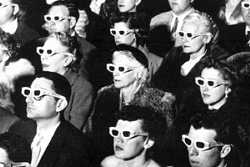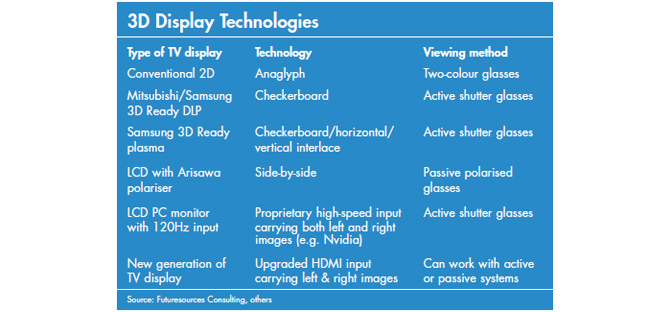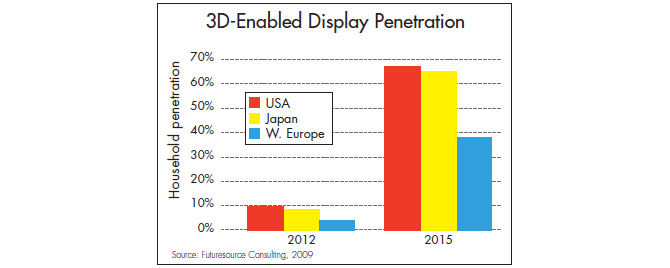Europe's online source of news, data & analysis for professionals involved in packaged media and new delivery technologies

ANALYSIS: Get those glasses ready - 3D is headed for your living room
A by-product of the migration to digital projection in cinemas is a re-emergence of a 1950s phenomenon... 3D movies. Hollywood now wants to bring the 3D experience into your home. BILL FOSTER, Senior Technology Consultant at Futuresource, explains.
Digital cinema (D-Cinema) has been around for about 10 years, but until recently it went largely unnoticed. This is because the perceived difference between digital projection and a new film print is minimal and the average cinemagoer is unlikely to spot it. A similar situation occurred when cinemas migrated from analogue to digital soundtracks; it was only with the arrival of 5.1 surround that audiences heard the change.
3D is D-Cinema’s ‘5.1’. Whilst 3D movies don’t actually need a digital projection system to work, it certainly helps. In the earlier incarnations of 3D during the ’50s, and again in the ’80s, people complained of headaches and nausea after watching a full-length feature, the primary reason being that with film it is almost impossible to align the two images as precisely as we would see them in real life. The brain therefore has to compensate and this creates the problems. Digital projectors, on the other hand, can be aligned with precision, and the other variable – optical differences in the lenses of the two cameras used to shoot the movie – can be corrected during post-production.
Cinemagoers’ reactions to the recent wave of digital 3D movies appear to have been positive, with people showing a clear preference for the 3D version where they have the option and a willingness to pay a premium of up to US$5 on the ticket price.
However, additional box office revenues from the fewer than 2,000 3D-equipped cinemas are not enough to cover the extra cost of producing a 3D movie, which can amount to several million dollars.
3D in the home requires unified approach
Because box office receipts only generate around 25% of the total revenue from a movie, extending 3D to non-theatrical markets such as home entertainment and broadcast is essential for the studios if the numbers are to add up. At present there are three different digital 3D projection technologies employed in cinemas: polarisation, active shutter glasses and spectral colour filter, also known as anaglyph. This lack of a single standard, whilst not ideal, is acceptable because each theatre is effectively a closed environment.
Broadcast and home video, on the other hand, are far more reliant on clearly defined standards, at least within a given territory. The home entertainment road is littered with examples of what happens when multiple ‘standards’ are allowed to co-exist.
With the Blu-ray/HD DVD battle still fresh in everyone’s minds, the industry is naturally keen to avoid a similar situation with 3D, but consensus will not be easy to achieve. Each industry segment has its own agenda, specific technical requirements and expectation of time to market.
The studios would like to have a 3D standard for home video right now in order to build upon the momentum being created in the cinemas. Although there will be some 3D releases on DVD, the majority are expected to be on Blu-ray and the Blu-ray Disc Association is now working actively on setting a standard. It is well aware of the need to reach a swift agreement.
3D presents a huge opportunity for the industry and there is a real feeling of excitement surrounding the technology. Looking at the TV market alone, over 200 million units are sold globally each year. Embedding custom chipsets into next-generation hardware will be relatively inexpensive and can be used to further enhance the offering of high-end displays, much in the way that LED backlighting and motion-blur reduction are currently being marketed. The resulting price premium will far outweigh the component and manufacturing costs associated with bringing a 3D-enabled set to market.
By 2015 it is expected that the majority of TVs available will be 3D-Ready and the normal replacement cycle will result in a good proportion of households in the US and Japan having a 3D-capable display.
Broadcast trials, but regular TV services some way off
A company in Japan is already broadcasting a limited 3D TV service via satellite for anyone willing to spend $2,500 on a specific type of TV fitted with a polarising filter. That price will inevitably fall over time, but how quickly and by how much will depend on uptake.
BSkyB in the UK has also been running a series of tests using this system but emphasises that these are purely technology trials and it has no intention of launching a 3D channel until there is a critical mass of suitably equipped TVs available.
BSkyB maintains that it’s not locked in to any particular technology, although it does have a preference for a ‘2D wrapper’ format, e.g. one that can be delivered over the same broadcast infrastructure as a conventional 2D image. This is not just a question of the infrastructure – satellite and cable operators’ set top boxes are built to a tight budget and do not have the spare processing power to decode 3D pictures. They need to pass the image through and rely on the TV to handle this function.
Different standards for Hollywood and broadcasters?
A drawback of ‘2D wrapper’ systems is that the pictures are not watchable on legacy 2D sets and so a 3D channel must be broadcast in addition to the 2D service. For a satellite or cable operator this does not present any real problem, but for terrestrial broadcasters it is a very different matter. In many cases they are already struggling to find the bandwidth for HD services and certainly don’t have the capacity available to launch a separate 3D channel any time soon.
Terrestrial broadcasters are therefore expected to opt for a compromise – a system that can deliver both 2D and 3D in the same broadcast channel. Hollywood, on the other hand, is indicating a preference for a ‘Full HD’ approach, taking advantage of the 40Mbps data rate that Blu-ray can deliver.
Blu-ray doesn’t suffer from the same bandwidth constraints as broadcast TV. Its peak video bit rate of 40Mbit/s should be able to accommodate two discrete video streams with ease. The big question is whether such as solution can be made backwards compatible – or if, indeed, it actually needs to be. Hollywood, in particular, may prefer to market two separate discs, possibly bundling a 2D DVD with the 3D BD for use elsewhere than the main TV set.
It is widely expected that a new generation of BD players will be needed for 3D, and to achieve the ‘Full HD’ resolution for both eyes will also require a new generation of TVs with an input capable of taking a double-rate video picture and separating the left and right eye images. A modification to the HDMI interface will also be required – something that’s already in progress.
During the research for our strategic 3D report, Futuresource Consulting carried out hundreds of interviews with those driving the 3D initiatives at the Hollywood studios, hardware vendors, cinema owners, broadcasters, content production companies, service providers and technology groups.
Short-term solution may deter consumers
Our findings indicate that putting all the elements in place for a successful 3D home video market will take at least two years. This presents Hollywood with a dilemma: does it settle for an interim 2D-compatible format such as anaglyph or wait until a high quality solution is available?
Some titles have already been released on Blu-ray and DVD in anaglyph, but consumer reaction has not been very favourable, particularly from those who saw the original cinema version. The studios are acutely aware that a bad consumer experience today could permanently damage the opportunity to market a 3D home video format when a better solution is ready for market and they are currently considering their short-term strategies.
Broadcasters are in less of a hurry. Aside from operators like BSkyB, which controls its own platform and could gain an immediate return through a premium subscription tier, the majority of broadcasters, particularly in Europe, will be happy to spend time deliberating over 3D standards as it will provide some breathing space while they deal with the more pressing issue of rolling out HD services.
Most of the major consumer electronics manufacturers showing proof-of-concept 3DTVs at January’s Consumer Electronics Show in the US some had more than one technology on display. Next January should see several pre-production prototypes and the first products are expected to hit the stores by the end of 2010.
By 2011, we expect 3D to start making a positive impact on the home video market and, with a wide range of content providers expected to join the Hollywood studios in creating a broad catalogue of 3D material, mainstream consumers will be encouraged to make the switch to 3D.
By then we’ll be seeing Blu-ray releases of new movies, 3D remasters of classic blockbusters like Star Wars, The Matrix and The Lord of the Rings, and a range of 3D TV content, particularly sport, wildlife documentaries and concerts. Selected TV shows and series will also be produced in 3D.
In 2012, more than 10% of US and Japanese homes will be ‘3D enabled’, and Western Europe won’t be too far behind. A new generation of videogame consoles will begin to appear, fully embracing 3D technologies, and in the longer term we may likely see the emergence of the Holy Grail – auto-stereoscopic (no-glasses) display.



BILL FOSTER is Senior Technology Consultant at Futuresource Consulting and a key contributor to the company’s recently published report on the future outlook for 3D. He has been involved with digital technology since the launch of CD in 1982. Contact: bill_foster@compuserve.com
Story filed 29.09.09



















